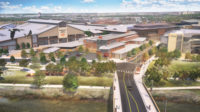California’s first true public-private partnership wastewater treatment plant in Santa Paula, Ventura County, will accept a P3 innovation award from the National Council for Public-Private Partnerships in an awards banquet in Tampa Oct. 4.
The project was put together in 2008 by the city of Santa Paula and a joint venture Santa Paula Water LLC, which is comprised of PERC Water Corp., Costa Mesa, and Alinda Capital Partners, Greenwich, Conn. Layton Construction, Irvine, was the prime subcontractor and PACE Engineering, Redding, was the engineer of record.
Santa Paula’s original wastewater treatment facility, built in 1939, was out of compliance and needed replacement, but the city did not have sufficient funds to pay for a new facility, according to PERC Water. The Regional Water Quality Control Board mandated a tight completion and compliance deadline or the city would be required to pay more than $8 million dollars in fines.
PERC Water spokeswoman Marian Clayton Clark said that due to the short timeline and cost-saving opportunities, Santa Paula’s city council cancelled its traditional design-bid-build process and moved the project forward using the design-build-operate-finance procurement process for its new facility. The contract runs for 30 years.
PERC Water contends that the design of the recycling plant blends in well with the surrounding community and utilizes a footprint of less than 2 acres, space which includes a 12,162-square-foot treatment facility and conceals a nearly 5.2 million gallon underground tank.
The recycling plant itself is designed for 3.4 million gallons per day (MGD) with expandability to 4.2 MGD. The plant has all new utilities, including fire, water, power, cable and gas, as well as features including an influent sewer lift station, three digester tanks, three anoxic tanks, three aerobic tanks, a UV disinfection tank and system, a foam control system, two-flow equalization tanks and a membrane bioreactor. The plant also includes administration buildings, including a control building with office space, lockers and restrooms, conference rooms, a receiving area and a headworks building, which will contain above-ground equipment as well as an odor control system. The effluent will be released from the plant and recycled into adjacent percolation ponds.
The plant opened its doors in May 2010.


Post a comment to this article
Report Abusive Comment